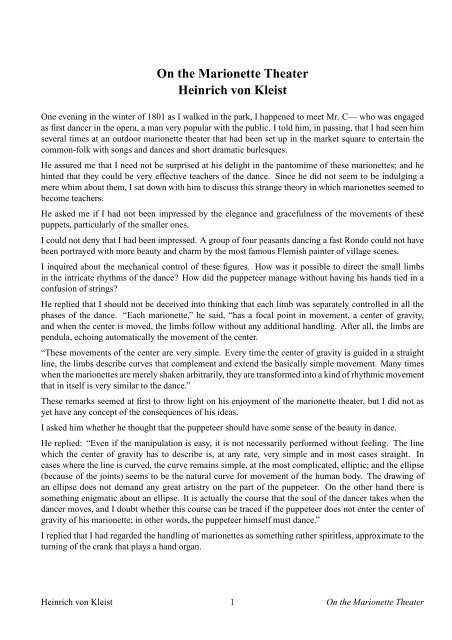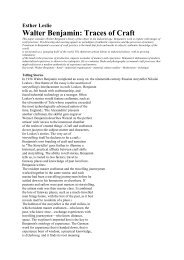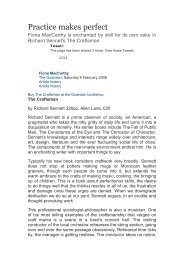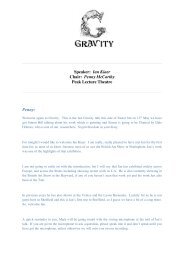On the Marionette Theater Heinrich von Kleist
On the Marionette Theater Heinrich von Kleist - Ada!
On the Marionette Theater Heinrich von Kleist - Ada!
You also want an ePaper? Increase the reach of your titles
YUMPU automatically turns print PDFs into web optimized ePapers that Google loves.
<strong>On</strong> <strong>the</strong> <strong>Marionette</strong> <strong>Theater</strong><strong>Heinrich</strong> <strong>von</strong> <strong>Kleist</strong><strong>On</strong>e evening in <strong>the</strong> winter of 1801 as I walked in <strong>the</strong> park, I happened to meet Mr. C— who was engagedas first dancer in <strong>the</strong> opera, a man very popular with <strong>the</strong> public. I told him, in passing, that I had seen himseveral times at an outdoor marionette <strong>the</strong>ater that had been set up in <strong>the</strong> market square to entertain <strong>the</strong>common-folk with songs and dances and short dramatic burlesques.He assured me that I need not be surprised at his delight in <strong>the</strong> pantomime of <strong>the</strong>se marionettes; and hehinted that <strong>the</strong>y could be very effective teachers of <strong>the</strong> dance. Since he did not seem to be indulging amere whim about <strong>the</strong>m, I sat down with him to discuss this strange <strong>the</strong>ory in which marionettes seemed tobecome teachers.He asked me if I had not been impressed by <strong>the</strong> elegance and gracefulness of <strong>the</strong> movements of <strong>the</strong>sepuppets, particularly of <strong>the</strong> smaller ones.I could not deny that I had been impressed. A group of four peasants dancing a fast Rondo could not havebeen portrayed with more beauty and charm by <strong>the</strong> most famous Flemish painter of village scenes.I inquired about <strong>the</strong> mechanical control of <strong>the</strong>se figures. How was it possible to direct <strong>the</strong> small limbsin <strong>the</strong> intricate rhythms of <strong>the</strong> dance? How did <strong>the</strong> puppeteer manage without having his hands tied in aconfusion of strings?He replied that I should not be deceived into thinking that each limb was separately controlled in all <strong>the</strong>phases of <strong>the</strong> dance. “Each marionette,” he said, “has a focal point in movement, a center of gravity,and when <strong>the</strong> center is moved, <strong>the</strong> limbs follow without any additional handling. After all, <strong>the</strong> limbs arependula, echoing automatically <strong>the</strong> movement of <strong>the</strong> center.“These movements of <strong>the</strong> center are very simple. Every time <strong>the</strong> center of gravity is guided in a straightline, <strong>the</strong> limbs describe curves that complement and extend <strong>the</strong> basically simple movement. Many timeswhen <strong>the</strong> marionettes are merely shaken arbitrarily, <strong>the</strong>y are transformed into a kind of rhythmic movementthat in itself is very similar to <strong>the</strong> dance.”These remarks seemed at first to throw light on his enjoyment of <strong>the</strong> marionette <strong>the</strong>ater, but I did not asyet have any concept of <strong>the</strong> consequences of his ideas.I asked him whe<strong>the</strong>r he thought that <strong>the</strong> puppeteer should have some sense of <strong>the</strong> beauty in dance.He replied: “Even if <strong>the</strong> manipulation is easy, it is not necessarily performed without feeling. The linewhich <strong>the</strong> center of gravity has to describe is, at any rate, very simple and in most cases straight. Incases where <strong>the</strong> line is curved, <strong>the</strong> curve remains simple, at <strong>the</strong> most complicated, elliptic; and <strong>the</strong> ellipse(because of <strong>the</strong> joints) seems to be <strong>the</strong> natural curve for movement of <strong>the</strong> human body. The drawing ofan ellipse does not demand any great artistry on <strong>the</strong> part of <strong>the</strong> puppeteer. <strong>On</strong> <strong>the</strong> o<strong>the</strong>r hand <strong>the</strong>re issomething enigmatic about an ellipse. It is actually <strong>the</strong> course that <strong>the</strong> soul of <strong>the</strong> dancer takes when <strong>the</strong>dancer moves, and I doubt whe<strong>the</strong>r this course can be traced if <strong>the</strong> puppeteer does not enter <strong>the</strong> center ofgravity of his marionette; in o<strong>the</strong>r words, <strong>the</strong> puppeteer himself must dance.”I replied that I had regarded <strong>the</strong> handling of marionettes as something ra<strong>the</strong>r spiritless, approximate to <strong>the</strong>turning of <strong>the</strong> crank that plays a hand organ.<strong>Heinrich</strong> <strong>von</strong> <strong>Kleist</strong> 1 <strong>On</strong> <strong>the</strong> <strong>Marionette</strong> <strong>Theater</strong>
“Not in <strong>the</strong> least,” he said, “<strong>the</strong> action of <strong>the</strong> puppeteer’s fingers is directly related to <strong>the</strong> movements of hismarionette, just as numbers relate to <strong>the</strong>ir logarithms; but <strong>the</strong>n it may be true that this last vestige of humanspirit can be eliminated from <strong>the</strong> marionettes; and <strong>the</strong>n <strong>the</strong>ir dance would be completely mechanized,performed with a crank as you have suggested.”I was surprised that he favored this minor variation of a great art form, surprised not only that he thoughtit capable of development but also that he seemed to concern himself with its development.He smiled and said: “I will even dare to maintain that if an artisan would follow <strong>the</strong> directions that I wantto give and build a marionette for me, I could have that marionette perform a dance which nei<strong>the</strong>r I norany o<strong>the</strong>r capable dancer of this era could duplicate.”I stared at <strong>the</strong> pavement between my feet. “Have you,” he asked, “seen <strong>the</strong> artificial legs that Britishartisans are manufacturing for amputees?”I said no; I had never seen anything of <strong>the</strong> sort.“I am sorry,” he answered, “because if I tell you that amputees dance with <strong>the</strong>se legs, I ra<strong>the</strong>r fear you willnot believe me.”“What,” I said, “dance?”“Yes, <strong>the</strong>ir sphere of movement is limited, but <strong>the</strong> movements that <strong>the</strong>y command <strong>the</strong>y perform with apoise, ease and gracefulness that would astound you.”I said jokingly that he had found his man. The artisan who was able to build such a remarkable leg should,doubtless, be able to build a marionette to his specifications.It was his turn to stare silently at <strong>the</strong> pavement. “What,” I asked, “are <strong>the</strong> specific demands you want tomake for your marionette?”“Nothing,” he said, “nothing that is unusual; simple harmonious proportion, mobility, ease of manipulation;but each of <strong>the</strong>se qualities must be developed to a higher degree; and most particularly <strong>the</strong> placementof <strong>the</strong> center of gravity must be more true to nature than in <strong>the</strong> common marionette.”“And what advantage would <strong>the</strong>se marionettes of yours have over <strong>the</strong> human dancer?”“Advantage . . . at first only a negative one. The marionette would never slip into affectation (if wethink of affectation as appearing when <strong>the</strong> center of intention of a movement is separated from <strong>the</strong> centerof gravity of <strong>the</strong> movement). Since <strong>the</strong> puppeteer has no control over any point o<strong>the</strong>r than <strong>the</strong> center ofgravity, and since this center is his only means of starting an intended movement, as <strong>the</strong> limbs follow <strong>the</strong>law of gravity and are what <strong>the</strong>y ought to be: dead, mere pendula. We look in vain for this quality in <strong>the</strong>majority of our dancers.”“Look at Miss P—” he continued, “when she plays Daphne, persecuted by Apollo, she looks back at him;<strong>the</strong> soul, <strong>the</strong> center of intention, is located in <strong>the</strong> lumbar vertebra; she bends down as if she would break;and young F— when, as Paris, he stands among <strong>the</strong> goddesses and presents <strong>the</strong> apple to Venus, his soul is(oh painful to behold!) in his elbow.“Great blunders,” he added, “are inevitable. We have eaten from <strong>the</strong> tree of knowledge; <strong>the</strong> paradise ofEden is locked up; and <strong>the</strong> Cherubim is behind us. We must wander about <strong>the</strong> world and see if, perhaps,we can find an unguarded back door.”I laughed. Certainly, I thought, <strong>the</strong> spirit cannot err when it is non-existent. But I saw that he had more onhis mind and I asked him to continue.<strong>Heinrich</strong> <strong>von</strong> <strong>Kleist</strong> 2 <strong>On</strong> <strong>the</strong> <strong>Marionette</strong> <strong>Theater</strong>
“These marionettes,” he said, “have ano<strong>the</strong>r advantage. They haven’t discovered <strong>the</strong> law of gravity. Theyknow nothing about <strong>the</strong> inertia of matter. In o<strong>the</strong>r words <strong>the</strong>y know nothing of those qualities most opposedto <strong>the</strong> dance. The force that pulls <strong>the</strong>m into <strong>the</strong> air is more powerful than that which shackles <strong>the</strong>m to <strong>the</strong>earth. What would not our dear G— give to be sixty pounds lighter or to have a force that would lift herfor her entrechats and pirouettes. These marionettes, like fairies, use <strong>the</strong> earth only as a point of departure;<strong>the</strong>y return to it only to renew <strong>the</strong> flight of <strong>the</strong>ir limbs with a momentary pause. We, on <strong>the</strong> o<strong>the</strong>r hand,need <strong>the</strong> earth: for rest, for repose from <strong>the</strong> effort of <strong>the</strong> dance; but this rest of ours is, in itself, obviouslynot dance; and we can do no better than disguise our moments of rest as much as possible.”I said that however cleverly he managed his paradoxes he would never make me believe that <strong>the</strong>re wasmore grace in a jointed mechanical doll than <strong>the</strong>re is in <strong>the</strong> structure of <strong>the</strong> human body.He replied: “It is simply impossible for a human being to reach <strong>the</strong> grace of <strong>the</strong> jointed doll. <strong>On</strong>ly a godcan duel with matter on this level, and it is at this point that <strong>the</strong> two ends of <strong>the</strong> ring-formed world graspeach o<strong>the</strong>r.”I was more surprised than before, and I did not know how to reply to <strong>the</strong>se strange statements.“It would seem,” he said, “that you have not read <strong>the</strong> third chapter of Genesis with sufficient attention; andif one does not understand <strong>the</strong> first period of human culture, it is difficult enough to talk about <strong>the</strong> periodsthat follow but almost impossible to discuss <strong>the</strong> very last period.”I said: “I know all too well <strong>the</strong> disorder that self-consciousness imposes on <strong>the</strong> natural grace of <strong>the</strong> humanbeing. Before my very eyes, a young acquaintance of mine ‘lost his innocence,’ and he has never recoveredhis lost paradise despite his efforts. But what consequences can you draw from that?”He asked me what had happened.“About three years ago,” I said, “I was bathing with a young man who at that time had a wonderful qualityof physical grace. He was about sixteen years old; and since he had only vaguely attracted <strong>the</strong> attentionof women, <strong>the</strong> first traces of vanity were barely discernible. It happened that we had both just seen <strong>the</strong>statue of <strong>the</strong> youth removing a splinter from his foot; (<strong>the</strong> cast of this sculpture is included in most Germancollections). As my young friend was drying himself, he put his foot an a stool; a glance at his reflection ina large mirror reminded him of <strong>the</strong> statue. He smiled and told me his discovery. In fact I had made <strong>the</strong> samediscovery at that very moment, but to counter his vanity I laughed and replied that he was seeing ghosts.He blushed and lifted his foot a second time to show me. Of course, <strong>the</strong> experiment failed. Confused, helifted his foot a third and fourth time; he lifted it possibly ten times in all and in vain. He was incapableof reproducing <strong>the</strong> gesture; in fact, <strong>the</strong> movement that he made had such an element of oddity that it washard for me to repress my laughter.“From that day on, practically from <strong>the</strong> very moment, <strong>the</strong> young man was changed. Day after day he stoodbefore a mirror, and one by one his charms fell away from him. An invisible and inconceivable pressure(like an iron net) seemed to confine <strong>the</strong> free flow of his gestures, and after a year had passed <strong>the</strong>re remainednot a trace of that loveliness that had so delighted everyone.”Mr. C— began very gently: “<strong>On</strong> this occasion I must tell you yet ano<strong>the</strong>r story. You will understand easilyhow it relates.“<strong>On</strong> my journey to Russia I stayed at <strong>the</strong> estate of Herr <strong>von</strong> G—, a Lithuanian nobleman, whose sons wereat that time intense in <strong>the</strong>ir practice of fencing. The older one, just back from <strong>the</strong> university, styled himselfa virtuoso and one morning offered me a rapier. We fenced, and it happened that I was victorious. Hispassion had added to his confusion; and almost every thrust that I made was a hit until finally his rapierwas knocked from his hand.<strong>Heinrich</strong> <strong>von</strong> <strong>Kleist</strong> 3 <strong>On</strong> <strong>the</strong> <strong>Marionette</strong> <strong>Theater</strong>
“As he picked it up, half in joke, half in irritation, he said that he had found his master, indeed that everyonein <strong>the</strong> world eventually found his master and that he would show me mine. The bro<strong>the</strong>r laughed heartilyand shouted: ‘Let’s go to <strong>the</strong> woodshed.’ And with that <strong>the</strong>y took me by <strong>the</strong> arm and led me to a bearwhich <strong>the</strong>ir fa<strong>the</strong>r had had raised in <strong>the</strong> yard.“As I approached, <strong>the</strong> bear stood erect with his back against <strong>the</strong> pole to which he was chained. He lookedme in <strong>the</strong> eye, his right paw raised; he was in fencing position. For a moment, confronted by this strangerival, I thought I was dreaming. ‘Foil, foil,’ said Herr <strong>von</strong> G—, ‘see if you can strike him.’ When I hadrecovered from my astonishment, I thrust at him with <strong>the</strong> rapier; <strong>the</strong> bear flipped his paw; <strong>the</strong> thrust wasparried. I tried to seduce him with a feint; <strong>the</strong> bear did not budge. With a sudden lunge I thrust again;I would absolutely have hit a human opponent; <strong>the</strong> bear flipped his paw, parried <strong>the</strong> thrust. I was in <strong>the</strong>same spot that young Herr <strong>von</strong> G— had been. The bear’s concentration added to my loss of composure.I alternated thrusts and feints; I sweated, in vain! Like <strong>the</strong> finest fencer in <strong>the</strong> world, <strong>the</strong> bear met andparried each thrust, but he did not respond to feints; (no fencer in <strong>the</strong> world could have matched him inthat). Eye to eye, as if he read my soul, he stood with his paw lifted, ready to fight; and if I did not intendmy thrust, he remained immobile.“Do you believe this story?”“Absolutely!” I exclaimed, applauding him. “I would believe it of anyone and how much more of you.”“Now <strong>the</strong>n,” said Mr. C—, “you have in your possession every means of understanding me. We see thatin <strong>the</strong> natural world, as <strong>the</strong> power of reflection darkens and weakens, grace comes forward, more radiant,more dominating . . . But that is not all; two lines intersect, separate and pass through infinity and beyond,only to suddenly reappear at <strong>the</strong> same point of intersection. As we look in a concave mirror, <strong>the</strong> imagevanishes into infinity and appears again close before us. Just in this way, after self-consciousness has, soto speak, passed through infinity, <strong>the</strong> quality of grace will reappear; and this reborn quality will appearin <strong>the</strong> greatest purity, a purity that has ei<strong>the</strong>r no consciousness or consciousness without limit: ei<strong>the</strong>r <strong>the</strong>jointed doll or <strong>the</strong> god.”“Therefore,” I said, a little distracted, “we must eat from <strong>the</strong> tree of knowledge again and fall back into astate of innocence.”“By all means,” he replied, “that is <strong>the</strong> last chapter in <strong>the</strong> history of <strong>the</strong> world.”<strong>Heinrich</strong> <strong>von</strong> <strong>Kleist</strong> 4 <strong>On</strong> <strong>the</strong> <strong>Marionette</strong> <strong>Theater</strong>





